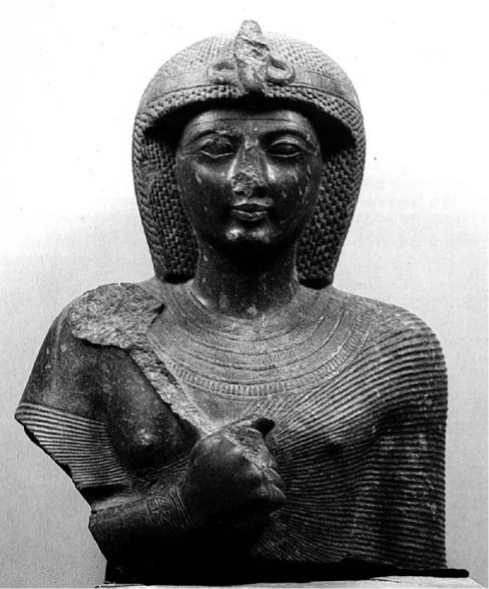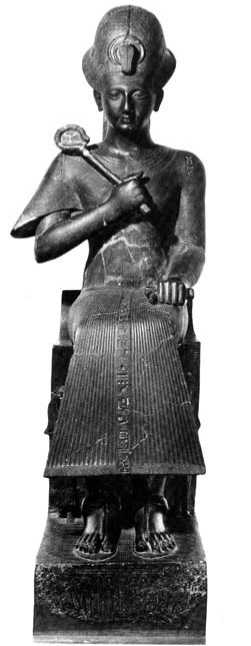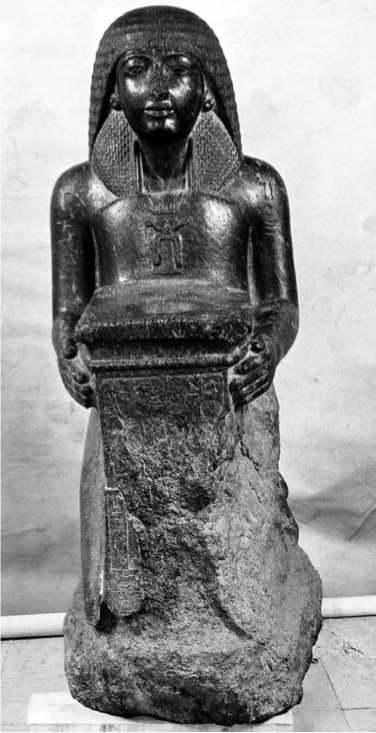The reign of Sety I marked a period of artistic rejuvenation, expressed at his Abydos, Karnak, Redesiya, and other construction sites. The idealized style of the king’s relief sculpture in his tomb and at Abydos reclaims a distinctive facial icon with a narrow hawkish nose, a pursed mouth taller than wide, and ovoid but open and horizontally set eyes. A kneeling granodiorite figure of the king offering a ka symbol altar shows these features and had been dedicated in the Abydos temple (MMA 22.2.21) (Hayes 1959; Sourouzian 1993). A statue in Vienna represents a new type for royal figures (Rogge 1990; Seipel 1992). The king in granodiorite is preserved from the lower face to the waist and wears a minutely plaited wig longer than shoulder length in front and shorter at the back. It is a wig type worn by Sety in a number of relief representations, including his tomb in the Valley of the Kings and on his battle reliefs from Karnak (Westendorf 1968: 178). The characteristic mouth of Sety I appears on this statue identifying it most probably as the king or his son Ramesses II. A falcon is spread across the back of the king’s head, and an obelisk-shaped back pillar appears beneath. The exceptional iconography continues in the introduction of the pleated shawl with sleeves over the king’s proper left shoulder and tied beneath his right breast. He holds a heka sceptre in his right hand. Although rather badly damaged, this exceptional statue represents elements of non-royal iconography that have migrated into royal sculpture. Both Ay and Horemheb were elites elevated to the kingship, and the latter, in particular, mixed the images from both periods of his functioning. Thus, in his elite Saqqara tomb, Horemheb wore elite clothing, such as Sety I wears on the statue, but artisans have added uraei to his images. The result is the elevation of the clothing into the royal environment. Statues of this type became common from this time, and a striding image of the king from Abydos wears a similar shawl and the same wig style as here (CG 751) (Borchardt 1930).
Sety I also dedicated a number of groups, including one from Karnak that was reconstituted by Hourig Sourouzian (Sourouzian 1998a) from some fragments found in the nineteenth century, some found in 1985 during work in the Akh-Menu of Thutmose III, and from a face in the Louvre (E 11100). The group represents Amun and Mut seated with a small figure of Sety standing before and between them. Sourouzian made the observation that the small size of the king vis a vis that of the deities was uncommon among the New Kingdom triad statues - which themselves were rather common - and that the other examples dated to the end of the
Eighteenth Dynasty. Another link for Sety I’s sculpture to the late Eighteenth Dynasty exists in his life-sized calcite composite statue, CG 42139, also discussed by Sourouzian (Sourouzian 1993). The ruler’s face carved in the soft sedimentary stone has a broad and thick mouth similar to those on post-Amarna sculpture, but the bodily proportions are those of the traditional 18-square grid. Since composite statuary was particularly characteristic of Amarna sculpture, it is possible that the artists of this statue had worked in the workshops of Akhetaten several decades earlier.
Ramesses II by any standard was a king among kings: during his sixty-seven years of reign Egypt’s ruling focus completed a shift northward that reflected military investments in the Levant and the threat of incursions from the Libyan west (figure 40.13). Although Thebes remained the religious capital for the national god Amon-re and, as such, received the attention and resources to continue building existing and new temples, the gods of Thebes, Memphis, and Heliopolis were now equally honored to emphasize the geographic expanse of Pharaoh’s rule. Statue groups of these deities multiplied in temples where the king made donations, and Ramesses frequently added deified forms of himself (Habachi 1969; Seidel 1980) Although, like his predecessors, the complete range of Ramesses’ statuary expressed the variety of roles associated with kingship in the New Kingdom: divinely ordained earthly ruler, priest of all cults, and guarantor of cosmic order, a large number of his images projected the elevation of the kingship itself to the ranks of full deification. While frequently having himself

Figure 40.13 Bust of Ramesses II. Granodiorite. Tanis. CG 616. Courtesy Supreme Council of Antiquities.
Sculpted amongst and at the same size as other national gods, such as Ptah-Tatenen, Re-Harakhty, Sekhmet, and Hathor, at the same time Ramesses’ wives and children were represented on his sculpture at a greatly reduced scale, thus separating their status from his. Family group statues are nearly non-existent during the reign of Ramesses II, and only occasionally were images of his queens made in similar size to his own (Seidel 1980; el-Masry 1998).
In Nubia, where even earlier kings were represented in deified forms, Ramesses proclaimed a nearly superior position vis a vis the major gods. At Gerf Husein, for example, Osirid statues of the ruler in the forecourt and hall are identified as ‘‘Ramesses, who has appeared with the gods,’’ while another is called ‘‘Ramesses in the temple of Ptah,’’ and yet another ‘‘Ramesses beloved of Atum.’’ Although the exact intent behind these names may be elusive, the insistence is upon Ramesses’ position as and among the gods. Even more esoteric are the statue identifications in the sanctuary of Gerf Husein, where four gods are represented: ‘‘Ptah of Ramesses in the temple of Ptah,’’ ‘‘lord of appearances Ramesses in the temple of Ptah,’’ ‘‘Ptah-Tatenen of Ramesses in the temple of Ptah,’’ and an illegible female deity (Kitchen 1979). The probability is that these deity names associated with Ramesses’ images were added after he began to celebrate his many jubilee festivals. His titulary also underwent changes after his union with the sun god during the Sed feasts, and the ‘‘gods of Ramesses’’ too may have indicated the result of such melding (Eaton-Krauss, 1984).
Although the emphasis on the divinity of the kingship was remarkable for Ramesses II’s sculptures, the types of royal works produced during his reign were largely familiar. There were single statues striding, standing, seated, kneeling, and offering. The king was shown carrying naoi and standards, wearing a rich assortment of headdresses, and assuming the form of a sphinx. So many statues were produced of Ramesses II over the decades that categorization and dating of the images are difficult. There were several model likenesses of the ruler, with variants of each, and it may not be that all (or any) attempted a form of portraiture. However, one model, perhaps only produced early in the reign, has elements in common with the facial features of Sety I, particularly adopting the long hawkish nose of Ramesses’ father. One of the king’s best known statues, a seated coronation type image now in the Turin Museum, illustrates this facial type well, but it is also represented by the calcite colossus from Memphis and a statue recently joined by Hourig Sourouzian from parts in the Cairo Museum (Sourouzian 1998a) (figure 40.14). These statues have generally roundish faces and lightly hooded eyes with somewhat narrow upturned mouths that are less thick than on his other likenesses.
The well-known bust of the king from Tanis on which he wears a pleated sleeved shawl and broad collar similar to the garb on the Turin sculpture has some features in common with that likeness, but here the face is distinctly not that of Sety. The round facial shape is enhanced by the spherical wig type, but it also has more modeling than the Turin statue does. The king’s mouth is still somewhat narrow and smiling but far fuller in the lips. It appears that most of the statues of Ramesses II were based on models similar to these facial features, some with rounder faces, wider and bulging eyes, and some with narrow, some quite broad sunken eyelids. A slightly altered version of this model was particularly popular for Ramesses II in Thebes - and at

Figure 40.14 Coronation-style statue of Ramesses II. Granodiorite. Turin Cat.1380. © Fondazione Museo Antichita Egizie di Torino - used with permission.
Luxor Temple and the Ramesseum in particular: this likeness deliberately emphasized features in common with Amenhotep III’s face, emulating his highly distinctive mouth almost exactly, with its central drooping bulge in the upper lip. It is well known that Ramesses II also had a series of striding granite colossal figures of himself made for the Luxor Temple’s first court, and these were placed alongside originals of Amenhotep III that had been reinscribed for the later ruler. The original gigantic seated figures of Ramesses before the Pylon and those within the court all repeated the homage to Amenhotep in their facial features, but it is important to note that the Ramessid originals always carved the king’s eyes rounder and with deep sunken eyelids in contrast to the narrower eyes and convex lids of the earlier king.
At his funerary temple Ramesses’ images were combined with works that earlier had represented Amenhotep III, whose own temple land was partially contiguous. The well-known ‘‘Younger Memnon’’ brought from the Ramesseum by Giovanni Belzoni early in the nineteenth century to London illustrates well the style of Ramesses’ sculptures that recall but do not exactly copy the face of his great predecessor (Leblanc 1999). Yet probably Ramesses’ son Merneptah took over more of Amenhotep’s images for use in his own funerary temple than did his father.
Ramesses II may have reused Amenhotep’s statues in other temple locations, particularly choosing from the large number of life-sized statues of deities placed there (Bryan 1997; Sourouzian, Stadelmann, et al. 2006).
With regard to the reuse of statues, the reign of Ramesses II is pivotal; for, although he did not introduce the practice, he utilized it extensively to complete the decoration of the many cult places where he was active. The choice of statues that Ramesses’ artisans reinscribed, retouched, and even reworked does appear to have favored certain kings, in particular, Senwosret I, Thutmose III, and Amenhotep III (Sourouzian 1988; 1995b; 1998b), and, although this may well have been because these kings’ colossal works graced such large temple complexes as Ptah’s in Memphis, Amun’s in Karnak, and Amun’s in Luxor, it is also probable that Ramesses also expected to gain some divine association with these great rulers by means of sharing their images. It has been noted that the historical consciousness of Egypt’s great past was notable during Ramesses’ reign - as witness the compilation of king lists and the pseudo-historical texts such as the 400-Year Stela (Eaton-Krauss 1984). The Nineteenth Dynasty was still new in the reign of Ramesses, and the uses of the past in establishing the legitimacy of this line of rulers - distinct from the irregularities of the late Eighteenth Dynasty kings - were likely brought to bear in monument-making as much as in text composition.
Non-royal statuary of the Nineteenth Dynasty is abundant enough to reflect both the length of Ramesses II’s reign and the relative stability of the period. Viziers, High Priests of Amun, and officials of all types dedicated sculptures of themselves in a variety of sizes and media and with a range of inscriptions upon them. Already in the Eighteenth Dynasty there was a large number of temple statues dedicated by private elites representing the dedicants as both recipients of and participants in cult ritual. This trend continued unabated in the Ramessid era, and in the major temples the types of sculptures presented were often quite traditional in form, even when styled to show current fashions in wig and clothing. The vizier Paser under Ramesses II dedicated a kneeling naophorous statue in Karnak showing himself in the archaistic vizier’s garb and in a style very like that of the late Eighteenth Dynasty, perhaps in hopes of linking himself with the office holders of the past (CG 42164) (figure 40.15). The scribe Hapy also placed a statue in Karnak: his sculpture shows him wearing the heavily pleated clothing and long echeloned wig of contemporary fashion. Hapy is posed seated with one leg up before him and the other down and tucked behind the other. This pose is well known from the Middle Kingdom but was not common at the time, and thus Hapy’s artists showed his appreciation of the past just as did Paser’s (CG42184) (Hawass 2008).
Yet the Ramessid era was not simply a continuation of the earlier New Kingdom as viewed from the private sculpture any more than from the royal. First, the sheer numbers of statues left during the period surely surpasses the Eighteenth Dynasty production levels, but the range of sites at which temple and tomb statuary of high quality occurs also appears to have expanded, particularly from the north and the border lands of Egypt. Just as Buhen and Gebel Barkal revealed the dedications of earlier elites stationed in Nubia, sites close to Mersa Matruh near the Libyan border have produced fine-quality sculptures from the time of Ramesses II, including a beautifully detailed standard bearer statue of one Nebre and a migdol-shaped naos

Figure 40.15 Vizier Paser, reign of Ramesses II. Granodiorite. Temple of Karnak. CG 42164. Courtesy Supreme Council of Antiquities.
Containing figures of Ptah and Sekhmet that reflected the garrison environment of the dedicants (Hawass 2002). At the same time officials at the southern end of the empire continued to donate statues in the Nubian temples during the later New Kingdom, for example, the Viceroy of Kush Setau under Ramesses II who placed a striding figure of himself in the Buhen sanctuary (CG 1134). Cult places between these border extremes were equally full of statuary, and elite tombs likewise received sculptures, as is amply indicated by the provenances to Saqqara and Qurna in the Egyptian Museum’s Catalogue general (Borchardt 1930).
When considering the types of statues offered in the Ramessid era the Karnak temple and its cachette excavated by Legrain provide an excellent overview. The types placed in Amun’s home frequently combined emblems of the deity with kneeling, seated, or standing figures of the dedicants whose cult participation carrying images of Amun in processions was thereby memorialized and made permanent (Legrain 1909). An unusual monument (Naples 1069) was dedicated by Ramesses II’s close friend Ameneminet and may have been either a temple or tomb object. Mummiform images in high relief ring a rectangular granodiorite block, and each figure is inscribed as an image of either Ameneminet himself or one of his family members. The overall work creates a family memorial that could function like a written genealogy, but perhaps also like a group ancestor bust, providing a link to deceased intercessors (Trapani 1998). In the body of temple statuary there are few female images attested, but numerous examples are known from tombs of the period. Further, among the vast numbers of statuary from the reign of Ramesses II images of queens and princes, not including groups with the king, are well attested and reflect the active roles undertaken by the royal family (el-Masry, 1998). A standard-bearing figure of a queen (now in the Metropolitan Museum of Art) claims a female sacerdotal responsibility during temple ritual otherwise known only for men (Scott 1992). It recalls the balance of priestly actions between the highest temple priests and the God’s Wife of Amun during the Eighteenth Dynasty as illustrated on Hatshepsut’s quartzite bark chapel (Robins 1983). The absence of a visible God’s Wife following the death of Queen Mother Tuya (Nefertari has the title on scarabs but not elsewhere) may have signalled the broader participation of royal females in palace and cult activities, in a manner similar to that found in the reigns of Amenhotep III and Akhenaten. In particular, Prince Khaemwese dedicated numerous statues of himself, and, although his primary function attached him to the Ptah temple in Memphis, his monuments were placed in cult places throughout the country and depict him with features similar to the two major models of Ramesses II.
The non-royal statuary of the later Ramessid era, as earlier, was designed to represent the dedicants performing a variety of roles that telegraphed social status (Sist 1997), but, if one compares the sculptures of the High Priests of Amun with those of contemporary rulers, it is clear that there is very little difference between the types produced. High Priest Bekenkhons left multiple images of himself in the Karnak temple (CG 42159-61), as standard bearer and naophore, but two were shown in striding poses wearing similar pleated garb to that on contemporary royal statues. Ramessesnakht, who served under Ramesses IV and later, dedicated a figure of himself offering an altar with the Theban triad atop it, indicating his closeness to the deities (CG 42162). A second statue took the form of a scribal figure, decidedly not royal in type, but the high quality was enhanced by an image of a baboon emerging from the back of the high priest’s head and visually claimed the presence of the god Thoth within Ramessesnakht (CG 42163) (figure 40.16). Since there was a series of scribal statues dedicated at Karnak by such major figures as Amenhotep, son of Hapu, Horemheb, and Paramesses - the last two having become kings - this scribal figure was likely also intended to assert the elevated status of the High Priest.
Royal statuary from the remainder of the Nineteenth Dynasty is far less numerous than earlier, and the proportion of reworked objects is also greater (Sourouzian 1989). Merneptah’s original monuments are, however, well attested at Memphis where he left a ceremonial palace that contained colossal standing images of the king carved in limestone. Elements of this palace are in the University of Pennsylvania Museum and show the king with a roundish face, ovoid eyes slightly less wide than Ramesses’, and a thin mouth. The icon is quite distinct from any statue face of Ramesses II, but the reworked images of Merneptah are less so. CG 607, found in

Figure 40.16 High Priest Ramessesnakht as scribe, reign of Ramesses IV. Granodiorite. Temple of Karnak. CG 42163. Courtesy Supreme Council of Antiquities.
The king’s mortuary temple, was recarved from a statue of Amenhotep III and has the narrower eyes and mouth seen on the Memphis statues, but, due to the thickness of the original mouth of Amenhotep III, the mouth is still somewhat thicker. A new type of statue is represented by CG 1240 of Merneptah in striding pose holding a captive in his left hand and a scimitar in his right. Although the figure is only a half meter in height, it is highly monumental, and the later statue representing Ramesses VI smiting owes much to it (Borchardt 1930). For Merneptah’s son Sety II a number of statues still remain, including a fine seated quartzite piece in the British Museum (EA 26) (Seidel 1980). Its features have much in common with those of Merneptah. A headless standard-bearer figure in the great Hypostyle Hall of Karnak is part of a group of six figures from that temple, and its head has been identified in the Metropolitan Museum of Art (34.2.2), although it was recarved as the image of Amenmesse (Cardon 1979; Yurco 1979). Contrary to earlier arguments, although the group of Karnak statues bore Amenmesse inscriptions with those of Sety II over them, they were likely originally of Sety II, whose reign was interrupted in a coup by his son Amenmesse (Dodson, 1997).

Figure 40.17 Ramesses III holding an image of Osiris. Greywacke. Temple of Ramesses III, Mut Precinct. Luxor Museum. Courtesy Supreme Council of Antiquities.
Royal sculpture of the Twentieth Dynasty introduces few new types, although one important one naming Ramesses III, now lost, was described as a healing statue with magical texts associating the king and a deity, perhaps Isis (Seidel 1980). Ramesses III left a large number of statues in his name, although a significant proportion of these, particularly from Thebes, were reworked or reinscribed from earlier rulers’ images. At the Karnak and Mut Temple, however, Ramesses left original colossal figures of himself, and within his Karnak small temple over life-sized Osirid figures were set against the pillars of the first court. At Medinet Habu similar architecturally placed figures of the ruler enhance the first two courts, although these may have been reused from an earlier temple (Stadelmann 2008). In his mortuary temple Ramesses reused a number of statues that had derived from Amenhotep III’s nearby temple and palace complex, including the cult image of Ptah in one of the rear cult chapels, as well as two granite dyads of the king with Maat and the king with Thoth. An enormous statue base of the earlier king with fecundity figures ringing it remains in the second court of Medinet Habu, and the distinctive style of the earlier ruler is discernible here and on much of the reused sculpture (Bryan 1997; Strauss-Seeber 1998). Ramesses III left a number of standard-bearing figures, as well as striding, kneeling, and seated

Figure 40.18 Ramesses VI smiting Libyan enemy. Granite. Temple of Karnak. CG 42152. Courtesy Supreme Council of Antiquities.
Royal images (Mojsov 2007). A figure of the king wearing a heavily pleated shawl and kilt with the round wig and double crown was found recently at the Ramesses III temple within the Mut precinct (Bryan 2005) (figure 40.17). The figure is incomplete, but the king, striding, held a small statue in front of him in the form of the mummiform god Osiris. The image of his son Pareherwenemef appears on the proper left of the statue in sunken relief. This greywacke life-sized figure of Ramesses III is of the highest quality and can be identified as the cult image for the king’s temple. In the sanctuary niche at the rear of the temple’s central aisle an image of Ramesses III appears in relief on the east side of the niche. The image shows Ramesses in similar garb holding an image of Osiris before him, suggesting strongly that the statue, which was cut into pieces in the Roman era and buried beneath the paving slabs ofthe central aisle, was indeed the principal cult image.
The royal statuary of the remainder of the New Kingdom shows several examples of the king carrying out activities, but smaller scaled figures dominated: the king offering, the king kneeling with an offering table, but also the king with a lion smiting an enemy are all known for Ramesses IV, the last having been repeated by Ramesses VI, who also reinscribed figures of his two predecessors (figure 40.18). Only one colossal image of a ruler is known from the reign of Ramesses IV to Ramesses XI, and takes the form of the upper half of a granite figure of Ramesses VI, CG 634. Although it remains uncertain, probably this represents an actual depiction of this king and has distinctive iconographic elements belonging to the late Ramessid era (Burger-Robin 2002).
FURTHER READING
Although no single work covering New Kingdom statuary exists, the interested reader will be well served to begin with Edna Russmann’s excellent overview of sculpture (1989). Russmann’s clear explanation both of the facts about the statues and of her own response to them is a superb introduction to an appreciation of Egyptian statuary. For the early New Kingdom, the exhibition catalogue edited by Catharine Roehrig (2005a) contains numerous excellent articles and entries that will assist the reader. Arielle Kozloff and Betsy Bryan (1992) likewise covers numerous aspects of the later Eighteenth Dynasty, while Dorothea Arnold (1996), as author and editor, and Jean-Luc Chappaz with Francesco Tiradritti as editors (2008) contain up-to-date discussions and interpretations of the fascinating Amarna era. Hourig Sourouzian has covered the Ramesside era in a number of works (see, in particular, Sourouzian 1989). A dissertation by Simon Burger-Robin (2002) has discussed the sculpture of the last kings of the New Kingdom.




 World History
World History









